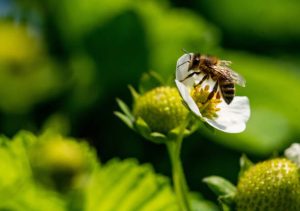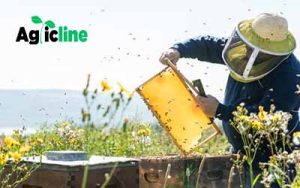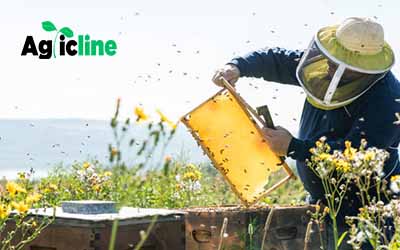In recent years, there’s been a noticeable shift towards more sustainable and environmentally friendly agricultural practices, with beekeeping standing out as a key area of interest.
This surge is driven by an increasing awareness of the critical role bees play in pollinating crops, supporting ecosystems, and producing valuable products like honey, beeswax, and propolis.
Bee farming, or apiculture, is more than just honey production; it’s an ancient practice that has evolved over centuries, adapting to the needs of society and the environment.
Today, it encompasses a wide range of techniques and philosophies, from traditional methods passed down through generations to modern, commercial operations designed to meet global demands.
There’s also a growing movement towards organic and urban beekeeping, reflecting a broader societal push towards sustainability and environmental stewardship.
The aim of this article is to explore the diverse world of bee farming, shedding light on the various types that exist today.
Each method has its unique benefits and challenges, contributing in its own way to our food systems, economies, and the health of our planet.

Types of bee farming
· Traditional Beekeeping
· Commercial Beekeeping
· Urban Beekeeping
· Organic Beekeeping
· Nomadic Beekeeping
· Conservation and Wild Bee Farming
Traditional Beekeeping
Traditional beekeeping holds a special place in the history and development of apiculture.
Practiced for thousands of years, it encompasses methods that have been passed down through generations, often closely tied to the cultural and environmental landscapes of different regions.
Traditional beekeeping is characterized by its low-tech and sustainable approach, relying on local materials and indigenous bee species to cultivate hives.
Unlike modern commercial beekeeping, traditional methods often prioritize the health and well-being of the bee populations over large-scale honey production.
This approach not only supports the local ecosystem but also fosters a deep connection between the beekeepers and their environment.
Hive Diversity
A fascinating aspect of traditional beekeeping is the variety of hives used, each adapted to its specific context.
From hollowed-out log hives suspended in trees to straw skeps and earthen pots, these hives reflect the ingenuity and resourcefulness of beekeepers across different cultures.
- Log Hives: Used in many parts of Africa and Eastern Europe, these hives are made from hollow logs and can be found hanging from trees, mimicking natural bee habitats.
- Clay Pots: In parts of the Middle East and Mediterranean, beekeepers use clay pots, which provide excellent insulation for the bees and are easy to construct from local materials.
- Straw Skeps: Once common across Europe, these dome-shaped hives are made from straw and mud, showcasing traditional craftsmanship.
The Cultural and Environmental Impact
Beyond its ecological benefits, traditional beekeeping is a testament to human ingenuity and our relationship with nature.
It offers valuable lessons in sustainability, showcasing how ancient practices can offer solutions to contemporary challenges, such as biodiversity loss and environmental degradation.
Commercial Beekeeping
Commercial beekeeping represents the modern evolution of bee farming, where the focus shifts towards large-scale production and efficiency.
This form of beekeeping plays a crucial role in agriculture and the global economy, providing essential pollination services and producing vast quantities of honey and other bee products.
Commercial beekeeping operations can range from hundreds to thousands of hives, utilizing advanced management techniques and technologies to optimize productivity.
These beekeepers often travel with their hives to provide pollination services across vast agricultural landscapes, from almond orchards in California to blueberry fields in Maine.
This migratory aspect of commercial beekeeping is essential for the pollination of many crops, underscoring the interdependence between agriculture and apiculture.
Commercial operations typically favor the European honey bee (Apis mellifera) for its productivity, gentleness, and adaptability to various climates and conditions.
- Economic Impact and Challenges
The economic contributions of commercial beekeeping are immense, not only in terms of honey and bee products but also through the value of pollination services, which are estimated to be worth billions annually to the global economy.
However, this sector faces several challenges, including the threat of pests and diseases like the Varroa mite, the impact of pesticides and environmental pollutants, and the pressures of climate change.
These issues require ongoing research, innovation, and collaboration between beekeepers, scientists, and policymakers to ensure a sustainable future for commercial beekeeping.
Commercial beekeepers also navigate a complex market, balancing the demand for honey, wax, and other products with the costs of production and competition from imported goods.
The rise of organic and artisanal honey products has opened new opportunities, yet also challenges beekeepers to maintain high standards of quality and sustainability.
Urban Beekeeping
Urban beekeeping has emerged as a popular hobby and sustainability initiative in cities around the world.
Amid concrete jungles, rooftop and backyard hives offer a glimpse of nature and a pathway to environmental stewardship.
This segment explores the rise of urban beekeeping, its benefits for urban ecosystems, and the considerations that aspiring and current beekeepers face in densely populated areas.
Urban beekeeping brings the ancient practice of apiculture into the heart of the city, transforming rooftops, balconies, and community gardens into buzzing havens of biodiversity.
The movement has gained momentum as individuals and communities become more interested in local food sources, pollinator health, and green living.
Urban hives not only produce honey but also support the pollination of city gardens, parks, and balcony plants, contributing to the urban green infrastructure.
- Benefits Beyond Honey
The significance of urban beekeeping extends far beyond the production of honey.
Urban hives play a critical role in promoting biodiversity by supporting a variety of pollinators essential for the health of urban green spaces.
Through workshops, school programs, and community events, urban beekeeping fosters a sense of connection to nature and a community spirit centered around environmental conservation.
- Navigating Urban Challenges
Urban beekeepers face unique challenges, from legal regulations and space constraints to managing bee health in areas with limited forage options.
Many cities have adopted beekeeping ordinances that specify hive management practices, setback requirements, and registration processes to ensure public safety and hive health.
- Building Community and Sustainability
Urban beekeeping initiatives often evolve into community projects, bringing together residents, businesses, and local governments in support of sustainable urban living.
Community gardens with hives become educational hubs, while businesses adopting rooftop beekeeping contribute to corporate sustainability goals.
These collaborative efforts not only enhance urban biodiversity but also strengthen community ties and promote environmental awareness.
Organic Beekeeping
Organic Beekeeping stands as a testament to the principles of organic farming, extending these ideals to the realm of apiculture.
It is characterized by practices that ensure the health and welfare of bees, the production of high-quality honey, and the preservation of the environment.
This segment explores the essence of organic beekeeping, the standards and practices that define it, and its growing appeal among consumers and beekeepers alike.
Organic beekeeping emphasizes the importance of maintaining natural bee habitats and behaviors.
This includes using organic materials for hive construction, avoiding synthetic chemicals for disease and pest management, and ensuring bees have access to organic forage.
The goal is to create a beekeeping environment that closely mimics the bees’ natural conditions, thereby supporting their health and resilience.
- Standards and Certification
To be recognized as organic, beekeeping operations must adhere to strict standards that regulate various aspects of hive management, bee forage, and handling of bee products.
These standards vary by country but generally include requirements such as the use of organic materials in hive construction, the prohibition of synthetic pesticides and antibiotics, and the provision of forage from organic sources within a certain radius of the hives.
Obtaining organic certification is a rigorous process that provides assurance to consumers about the quality and sustainability of the bee products they purchase.
- The Challenges of Organic Beekeeping
Organic beekeeping presents its own set of challenges, particularly in pest and disease management.
Without the use of synthetic chemicals, organic beekeepers must rely on natural remedies and management practices to keep their hives healthy.
This often requires a deeper understanding of bee biology and behavior, as well as a commitment to ongoing education and adaptation to new organic methods.
The Benefits: For Bees, Consumers, and the Environment
Despite these challenges, organic beekeeping offers numerous benefits. For the bees, it provides a healthier and more natural living environment, potentially leading to stronger and more resilient colonies.
For consumers, it offers honey and other bee products free from synthetic chemicals, aligning with growing demands for organic and sustainably produced foods.
For the environment, organic beekeeping supports biodiversity and promotes the health of ecosystems through the use of chemical-free practices.
Nomadic Beekeeping
Nomadic Beekeeping, also known as migratory beekeeping, is a practice as old as beekeeping itself, where beekeepers move their hives to different locations to take advantage of seasonal flower blooms.
This mobile approach not only maximizes honey production but also provides crucial pollination services to a variety of crops, supporting agriculture and biodiversity.
Nomadic beekeeping traces its origins back to ancient times when beekeepers observed the benefits of moving hives to areas with abundant forage.
In today’s agricultural landscape, this practice has evolved into a highly organized operation, with beekeepers transporting thousands of hives across continents to pollinate crops, from almond groves in California to blueberry fields in Maine.
This migratory pattern is synchronized with the flowering cycles of crops and wild plants, ensuring that bees have a constant source of nectar and pollen.
- The Agricultural Impact
The primary value of nomadic beekeeping lies in its pollination services, which are essential for the production of many fruits, nuts, and vegetables.
By moving hives to areas where crops are in bloom, beekeepers help ensure the pollination of plants, significantly increasing crop yields and quality.
This symbiotic relationship between beekeepers and farmers is a cornerstone of modern agriculture, contributing to food security and the agricultural economy.
- Challenges and Environmental Considerations
While nomadic beekeeping is beneficial for crop pollination, it also poses challenges, particularly in terms of biosecurity and the potential spread of diseases and pests among bee populations.
The stress of transportation can also affect bee health and longevity. Furthermore, there is ongoing debate about the impact of large-scale commercial pollination on local ecosystems and native bee populations.
Beekeepers must therefore balance the economic benefits with responsible practices to minimize negative environmental impacts.
Conservation and Wild Bee Farming
Conservation and Wild Bee Farming focuses on the intersection of beekeeping with environmental conservation, aiming to protect and enhance the populations of wild bees and other pollinators.
This approach is vital in the context of declining bee populations worldwide, threatened by habitat loss, pesticide use, and climate change.
- The Plight of Wild Bees
Wild bees, including solitary bees, bumblebees, and other non-honeybee species, play an essential role in pollinating wild plants and many crops.
However, their numbers are declining at an alarming rate, posing a serious risk to global biodiversity and food security.
Conservation and wild bee farming practices are critical in addressing these challenges, providing habitats and forage to support healthy populations of wild pollinators.
- Creating Habitats for Pollinators
One of the core strategies of conservation bee farming is the creation and preservation of habitats that support wild bee populations.
This includes planting native flowers, establishing wildflower meadows, and maintaining hedgerows and other natural features within agricultural landscapes.
Such efforts not only benefit wild bees but also enhance the overall biodiversity of the area, supporting a wide range of wildlife.
- Sustainable Beekeeping Practices
Beekeepers can contribute to conservation efforts by adopting practices that minimize the impact on wild bee populations and the environment.
This includes reducing the use of chemicals in beekeeping, promoting genetic diversity within honeybee populations, and ensuring that managed bees do not compete with wild pollinators for resources.
By integrating conservation principles into beekeeping practices, beekeepers can support the health of both managed and wild bee populations.
- Community and Educational Initiatives
Raising awareness about the importance of wild bees and the threats they face is a crucial aspect of conservation bee farming.
Community projects, educational programs, and citizen science initiatives can play a significant role in promoting pollinator conservation.

Concluding remark on Types of bee farming
Bees, both wild and managed, are fundamental to the health of natural and agricultural landscapes, pollinating a vast array of plants that support life on earth.
The challenges faced by bees – from habitat loss and pesticide exposure to diseases and climate change – are reminders of the delicate balance required to sustain these essential creatures and, by extension, our own livelihoods.
Since your opinion counts on our platform, feel free to air your view in the comment box below.
Recommendations
What are the 10 problems of agriculture?
5 Top Challenges faced by farmers in India
10 Environmental benefits of beekeeping
4 Advantages of continuous grazing



